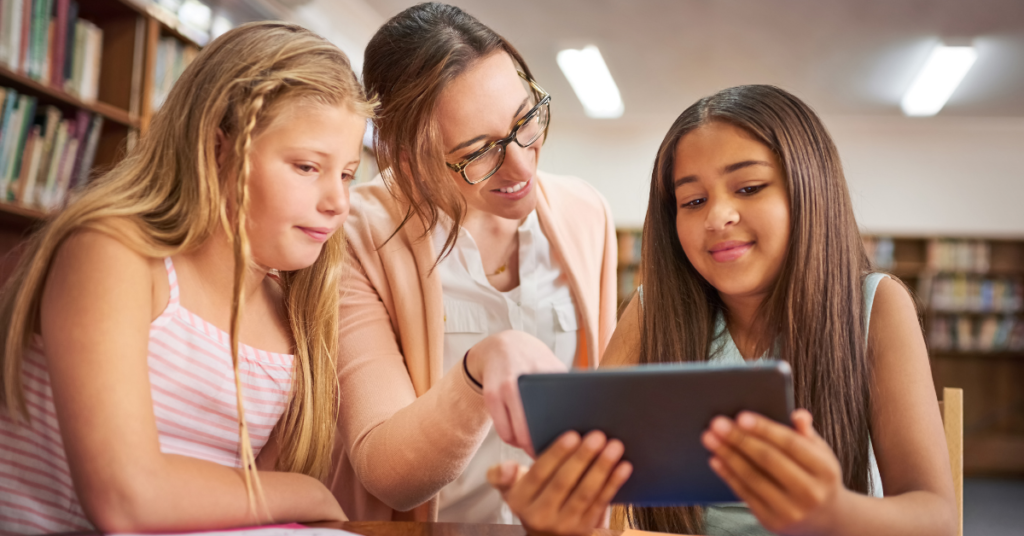

Written by Ana Rynders & Leslie Kiel
Professional Development Specialists
Five Star Technology Solutions
“A Regular Year”
For many schools, this year means more funding and an even bigger push to innovate and advance our digital tools. As a whole, education has been wisened by the transition in and out of remote, hybrid, and in-person learning experiences. Some of us have unprecedented access to student devices while others have had devices for awhile. We might be wary (and weary) of what technology we are using and of the power and potential that devices in the classroom bring. Whatever our position, educational technology is becoming even more readily available.
The ever-growing world of edtech can make us feel that we have to do it all, all at once, and all of the time. That’s just not true. We know students & educators crave human connection and familiar, natural communities. You don’t throw good teaching out the window and replace it with more screen time. Managing a classroom with devices is not only possible; it’s quite similar to managing a classroom without them. So, how do you manage all of the tech and still put students and their learning first? Give your teacher heart and brain the freedom to do what is best for you and for your classroom. Three things remain paramount: relationships, communication, and modeling.

Prioritizing Relationships
Veteran teachers know that great classroom management isn’t about ruling with an iron fist; it’s about building meaningful relationships with students. In the first days of school, make time for connections and conversations as a class community. Release yourself from what you’ve always done and realign to what is most important. Invite students to co-author classroom norms and build the learning environment. Get to know your students! Consider implementing a student interest survey. Become a student of your learner’s interests so that you can develop enticing and engaging experiences for your classroom. Launch Smart Start protocols. With these handy multi-use lessons, you can teach the tech and build relationships. Later, use these same protocols with content-specific topics.
Consider the way building your digital toolbox will influence your classroom management, and then permit yourself to become practiced and fluent with one or two digital tools. Level up your skills with that certain tool, and try implementing it in a new way. For example, if you love Google Slides, use Pear Deck to make your beloved presentations interactive. Are you a data person? Try Flippity to create a trivia quiz show with your academic content, or build an interactive scavenger hunt using Google Sheets. Remember, skillful technology integration is not about quantity of technology, but quality of the learning experience. While a stronger digital toolbox may seem far-removed from classroom management, a handful of powerhouses increases engagement and buy-in, one of your strongest weapons against management issues!
Clear, Consistent Communication
Consider adopting tech tools that make communicating easier; share, store, and redistribute information as many times as needed. Use Google Classroom Guardian Summaries to bridge the gap for your digital classroom to families. Class Dojo and Seesaw support regular communication from home to school along with a student created digital portfolio. Looping parents in on expectations in such a way creates buy-in that’s irreplaceable; if you create proper usage videos for students, include them in class newsletters. As the adage says, “it takes a village.” Quality communication develops trusting relationships between you and the families that you serve. Explicitly discuss how, when, and why you are using technology. Cover how students will use devices in your class.
- Will they be expected to bring their fully charged device to your class with them every day?
- Will you post all assignments in your learning management system, even those that are “unplugged?” How will you manage student learning digitally?
- Why are you using the digital tools you have chosen?
Just as we write and adhere to procedures on the reading rug, transitions in the hallway, or assembling for lunch at the cafeteria door, we must have guidelines for students when using technology. Successful classroom management happens when students know what to expect, so start from a place of zero assumptions. How many times have you thought mid-class, “Is anyone even listening to me?” Oh the woes of repeating yourself as a classroom teacher! Whether it’s selective hearing or poor information absorption, you may be tempted to cross your fingers and assume they heard you. DON’T. Consider the ways you can transmit information without saying a word. One possibility from Common Sense Education is to use a visual cue such as a “poster of a stoplight, and [moving] a clothespin to indicate whether devices are in use (green), put to the side (yellow), or off and stored (red).”
Routines, Structures, & Modeling
It won’t be enough to simply state expectations about device use. Routines must be established, put in writing, and revisited often. Build routines that encourage mindfulness to increase student confidence and ownership of their learning. Consider your students and their needs first. Do you have a particularly chatty bunch? Likely, they’ll benefit from a transition signal to and from digital work time. According to Zaretta Hammond in the book, Culturally Responsive Teaching & the Brain: Promoting Authentic Engagement and Rigor Among Culturally and Linguistically Diverse Students, a call and response strategy can assist you. Get your learners’ attention, deliver a directive/content, and activate their response. Model what you expect students to do with the tool. For example, before sending students into a digital platform such as Jamboard to collaborate as a whole class, have them first work on an individual level as you demonstrate appropriate behavior. Solo time in a tool allows students to become more proficient before bringing collaboration (and all the considerations that come with it) into the equation. As you model, consider sharing your thought-process aloud and discuss how and why you are using the tool during learning.
Intense pressure in this year is evident. Likely, you’re pushing for it to be just right or practically perfect as passionate educators do. Teaching with technology is a learning experience for all involved, so let go of unrealistic expectations for perfection. Let compassion and grace for your students and colleagues swell to include yourself. This will not be “a regular year.” You likely won’t get everything right the first time, and that is ok. Keep people first. Share your intentions early and often as they adapt. Finally, support your people with routines as best as you can. Remember, while the tools may evolve and change, good classroom management centers on trusting relationships, specific communication, and polished rehearsal. In the words of Eboni Zook, 2020-2021 CSTA Equity Fellow, “Liberate yourself.”

